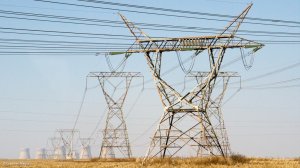South Africa targets ‘highly concessional’ terms as it moves to negotiate $8.5bn climate deal
If South Africa is unable to secure highly concessional terms from the international partners that have offered $8.5-billion to support the country’s energy transition and to provide social protection for workers and communities associated with the coal value chain, it will not pursue the transaction, an official in The Presidency said on Tuesday.
Speaking at an event hosted on the sidelines of COP26, Rudi Dicks, who is programme management officer in the private office of the President, emphasised that no agreement had yet been concluded and that South Africa could still “walk away if we feel that the conditions are too onerous”.
“[The funding] has to be highly concessional – it has to benefit us.
“It shouldn’t be equal to or just below the kind of financing that we could secure on the open bond market,” he said.
On November 2, South Africa, France, Germany, the UK and the US, along with the European Union, announced a ‘Just Energy Transition Partnership’ to support South Africa’s decarbonisation efforts in line with the country’s updated Nationally Determined Contribution emissions goals.
The announcement has received a mixed reception with some lauding it as an important breakthrough in South Africa’s shift from coal to renewables, and others raising concern that the deal could result in the precipitous closure of coal power stations, with negative consequences for electricity supply and the economy.
The declaration was unveiled against the backdrop of a return to an intensive phase of load-shedding, triggered, yet again, by the deteriorating performance of Eskom’s aging and under-maintained coal fleet, the energy availability factor of which has fallen to below 65%.
Dicks said that the “nuts and bolts” of the deal, including the sources and mix of funding and whether any government guarantees would need to be extended, still had to be negotiated.
The declaration makes provision for the establishment of a task force, comprising representatives from South Africa and the international partners, to finalise the funding mechanism.
The task force would negotiate the ratio of grants to loans, as well as give greater definition to the nature of the concessional loan terms and their tenure.
“The devil is in the detail, of course, and that’s the next step,” Dicks said, adding that the initial focus would be on Eskom projects, even though the scope of government’s just transition planning had been extended to the manufacture of electric vehicles and the development of a green hydrogen industry.
Dicks confirmed that any deal would be concluded by government rather than Eskom, given that the facility would be used to support initiatives outside of the electricity sector.
South Africa would be assembling an expert finance team, involving participants from both within and outside of government, “to enter into very tough negotiations over the next six months to secure the offer that has been made”.
The team would assess all the risks, including those relating to South Africa’s volatile exchange rate, which Dicks flagged as a significant risk factor.
Speaking on the same platform, Eskom just transition office head Mandy Rambharos underlined the utility’s stance that it saw the funding as only the first step in a far larger programme that would necessarily involve both Eskom and the private sector.
Eskom’s investment pipeline included a mix of generation, transmission and distribution projects collectively valued at about R400-billion ($26-billion) and the funding would be insufficient, she said, to guarantee long-term security of supply.
On the generation front, Eskom has projects with a combined capacity of only 8.5 GW, while it would be decommissioning 22 GW of coal, which would have to be replaced by a renewables fleet of up to 60 GW.
It also needed to invest about R170-billion to add additional grid capacity, including the building of 8 000 km of transmission lines.
Rambharos said that beside the financing, it was important that the policy and regulatory frameworks were in place to support the investments required for the just energy transition.
“We can talk until we are blue in the face about what projects we can implement, but if we don’t have the regulatory and the policy support, we will fail,” she said.
Comments
Press Office
Announcements
What's On
Subscribe to improve your user experience...
Option 1 (equivalent of R125 a month):
Receive a weekly copy of Creamer Media's Engineering News & Mining Weekly magazine
(print copy for those in South Africa and e-magazine for those outside of South Africa)
Receive daily email newsletters
Access to full search results
Access archive of magazine back copies
Access to Projects in Progress
Access to ONE Research Report of your choice in PDF format
Option 2 (equivalent of R375 a month):
All benefits from Option 1
PLUS
Access to Creamer Media's Research Channel Africa for ALL Research Reports, in PDF format, on various industrial and mining sectors
including Electricity; Water; Energy Transition; Hydrogen; Roads, Rail and Ports; Coal; Gold; Platinum; Battery Metals; etc.
Already a subscriber?
Forgotten your password?
Receive weekly copy of Creamer Media's Engineering News & Mining Weekly magazine (print copy for those in South Africa and e-magazine for those outside of South Africa)
➕
Recieve daily email newsletters
➕
Access to full search results
➕
Access archive of magazine back copies
➕
Access to Projects in Progress
➕
Access to ONE Research Report of your choice in PDF format
RESEARCH CHANNEL AFRICA
R4500 (equivalent of R375 a month)
SUBSCRIBEAll benefits from Option 1
➕
Access to Creamer Media's Research Channel Africa for ALL Research Reports on various industrial and mining sectors, in PDF format, including on:
Electricity
➕
Water
➕
Energy Transition
➕
Hydrogen
➕
Roads, Rail and Ports
➕
Coal
➕
Gold
➕
Platinum
➕
Battery Metals
➕
etc.
Receive all benefits from Option 1 or Option 2 delivered to numerous people at your company
➕
Multiple User names and Passwords for simultaneous log-ins
➕
Intranet integration access to all in your organisation





















